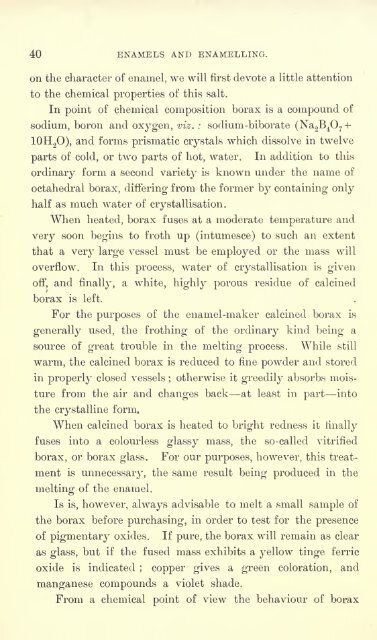Enamels and enamelling; an introduction to the preparation and ...
Enamels and enamelling; an introduction to the preparation and ...
Enamels and enamelling; an introduction to the preparation and ...
Create successful ePaper yourself
Turn your PDF publications into a flip-book with our unique Google optimized e-Paper software.
40 ENAMELS AND ENAMELLING.<br />
on <strong>the</strong> character of enamel, we will first devote a little attention<br />
<strong>to</strong> <strong>the</strong> chemical properties of this salt.<br />
In point of chemical composition borax is a compound of<br />
sodium, boron <strong><strong>an</strong>d</strong> oxygen, viz. : sodium-biborate (Na 2 B 4O 7 +<br />
10H 2O), <strong><strong>an</strong>d</strong> forms prismatic crystals which dissolve in twelve<br />
parts of cold, or two parts of hot, water. In addition <strong>to</strong> this<br />
ordinary form a second variety<br />
is known under <strong>the</strong> name of<br />
octahedral borax, differing from <strong>the</strong> former by containing only<br />
half as much water of crystallisation.<br />
When heated, borax fuses at a moderate temperature <strong><strong>an</strong>d</strong><br />
very soon begins <strong>to</strong> froth up (intumesce) <strong>to</strong> such <strong>an</strong> extent<br />
that a very large vessel must be employed or <strong>the</strong> mass will<br />
overflow. In this process, water of crystallisation is given<br />
off, <strong><strong>an</strong>d</strong> finally, a white, highly porous<br />
borax is left.<br />
residue of calcined<br />
For <strong>the</strong> purposes of <strong>the</strong> enamel-maker calcined borax is<br />
generally used, <strong>the</strong> frothing of <strong>the</strong> ordinary kind being a<br />
source of great trouble in <strong>the</strong> melting process. While still<br />
warm, <strong>the</strong> calcined borax is reduced <strong>to</strong> fine powder <strong><strong>an</strong>d</strong> s<strong>to</strong>red<br />
in properly closed vessels ;<br />
o<strong>the</strong>rwise it greedily absorbs mois-<br />
ture from <strong>the</strong> air <strong><strong>an</strong>d</strong> ch<strong>an</strong>ges back at least in part in<strong>to</strong><br />
<strong>the</strong> crystalline form.<br />
When calcined borax is heated <strong>to</strong> bright redness it finally<br />
fuses in<strong>to</strong> a colourless glassy mass, <strong>the</strong> so-called vitrified<br />
borax, or borax glass.<br />
For our purposes, however, this treat-<br />
ment is unnecessary, <strong>the</strong> same result being produced in <strong>the</strong><br />
melting of <strong>the</strong> enamel.<br />
Is is, however, always advisable <strong>to</strong> melt a small sample of<br />
<strong>the</strong> borax before purchasing, in order <strong>to</strong> test for <strong>the</strong> presence<br />
of pigmentary oxides. If pure, <strong>the</strong> borax will remain as clear<br />
as glass, but if <strong>the</strong> fused mass exhibits a yellow tinge ferric<br />
oxide is indicated ; copper<br />
gives a green coloration, <strong><strong>an</strong>d</strong><br />
m<strong>an</strong>g<strong>an</strong>ese compounds a violet shade.<br />
From a chemical point of view <strong>the</strong> behaviour of borax
















